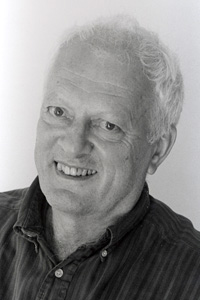History
A brief overview of the development of the University of Manchester Centre for Atmospheric Science

The Centre for Atmospheric Science has its origins in The Atmospheric Physics Research Group in The Faculty of Technology of The University of Manchester (the Faculty of Technology later became UMIST). The group was founded in 1961 by John Latham when he was appointed as a lecturer. His PhD work, under Professor Mason (later Sir John Mason, Director of the Meteorological Office, and later still, Chancellor of UMIST), was in the Cloud Physics Research Group at Imperial College, London. John Latham’s lifetime interest in atmospheric electricity stemmed from his PhD research into mechanisms of thunderstorm electrification. His early work in Manchester continued laboratory studies into various aspects of the role of cloud particles in electric fields. John set up the first of four cold rooms in the Sackville Building in which cloud conditions down to -40°C could be simulated.
Laboratory work in atmospheric electricity was continued by John’s research students - Dave Stow (snowstorm electrification, 1966), Abul Azad (liquid evaporative charging, 1968), Clive Saunders (effects of thunderstorm electric fields on ice particle aggregation, 1969), Mohe Abbas (instability of charged water drops, 1967), Peter Brazier-Smith (numerical model of drop disruption, 1969), Mike Smith (drop disruption in electric fields, 1970), Gerard Jennings (drop collisions in electric fields, 1971), Richard Griffiths (corona from drops, 1973), John Crab (lightning triggering, 1973), Mike Gay (terminal velocities of drops in electric fields, 1974), Robert Warwicker (splashing of supercooled drops, 1978), Eva Barker (the raingush, 1978), Tej Verma (the raingush, 1979), Alan Barlow (charged raindrop scavenging, 1980), Carolyn Allen (drop splashing, 1980), Peter Kinsey (discharge biogenesis, 1986).
John’s interests moved into cloud particle development with studies of particle growth, mixing and entrainment: Roger Reid (cloud mixing, 1975), Andy Chittenden (droplet sizes, 1976), Tom Choularton (ice particle initiation and growth, 1977), Rob Corbin (droplet size distributions, 1979), Tej Verma (the raingush, 1979), Colin Mill (droplet collisions, 1980), Barry Gardiner (entrainment in clouds and fogs, 1982), Alan Blyth (entrainment effect on droplets, 1982), Peter Moody (cloud mixing, 1983), Ian Consterdine (IR visibility, 1984).
Other lecturing staff joined the research group over the years – Dave Stow, Clive Saunders, Jim Cross, Anthony Illingworth, Mike Smith, Tom Choularton, Tony Bicknell, George Whiterod, Stewart Darlow, Martin Gallagher, Ann Webb, Hugh Coe, Carl Percival, Gordon McFiggans and Paul Connolly.
In 1989, Peter Jonas joined the group from the Meteorological Office and took over as head of the research group. His interests included the radiative effects of clouds, involving numerical modelling studies. Peter was involved with airborne research and was instrumental in the acquisition of the national facility BAE 146 research aircraft – initially purchased through UMIST.
Tom Choularton took over as head of the research group in 1997. Tom’s research has involved field work on Great Dun Fell with studies of the feeder/seeder mechanism; cloud studies involving the aircraft; cirrus clouds, and most recently, atmospheric chemistry.
Geraint Vaughan joined the group in 2004, together with his research group from Aberystwyth, with interests including lidar studies of severe storms.
Following the merger between UMIST and The Victoria University of Manchester in October 2004, the Centre for Atmospheric Science left the department of Physics and became a part of the School of Earth, Atmospheric and Environmental Sciences. In August 2007 the centre moved from its old home in the Sackville Street Building (formerly UMIST main building) to newly refurbished facilities in the Simon Building, bringing it closer geographically to the rest of the school. On 19th August 2008 these new facilities were officially opened by Professor John Latham and were named the Latham Laboratories.
David Schultz joined the group in 2009. Previously, he spent three years as Professor of Experimental Meteorology at the University of Helsinki and the Finnish Meteorological Institute, after having been a research meteorologist for ten years at the NOAA/National Severe Storms Laboratory and University of Oklahoma. His research interests are in extratropical cyclones, fronts and convective storms, as well as cloud and precipitation processes. He brings an extensive experience of interacting with forecasters to help improve techniques and understanding in weather prediction.